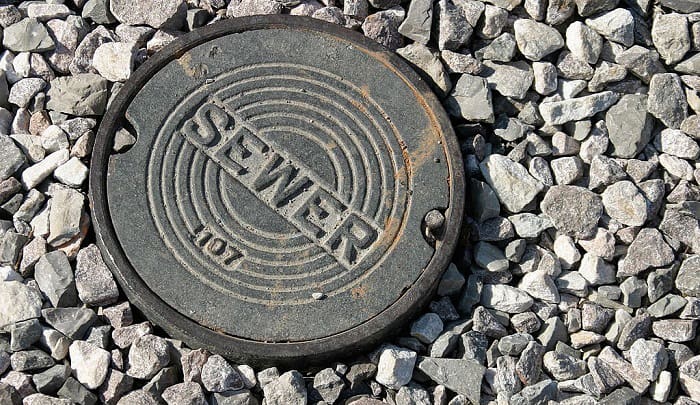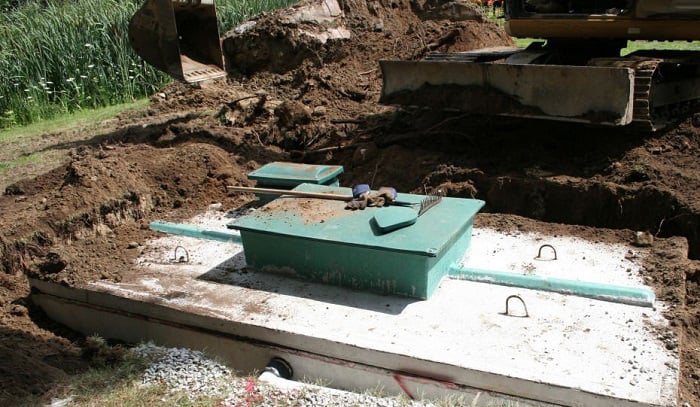When you flush the toilet, where does the sewer water go? The exact answer will depend on whether you have a septic tank or are connected to a separate or combined sewer system.
Septic systems usually have a plastic, concrete, or fiberglass tank that is buried underground. This tank collects all the waste, and the solids stay at the bottom for decomposition.
In the case of a separate sewer system, the solid waste and the wastewater go to the drain for waste collection. If it’s a combined system, the waste from your house goes to the drain that also collects rainwater. For more details, read on.
Where Does All the Sewer Water Go?
Talking about the route that the sewer leads to is a matter of sanitation. Proper practices are crucial to not spread diseases.
Think about the contents of toilet water such as wastewater or feces, soap, lube, cleaning products, sink water, and even food waste.
Aside from creating a system where waste can go when it goes down the drain, there’s also a sanitation system. This promotes the treatment of wastewater. Once the wastewater goes through the water cycle, contaminants are removed.
The following are the standard steps for treating sewer water:
- Controlling odors – This procedure ensures the use of chemicals to eliminate sewer water odor.
- Screening – This process comprises running water through screens to segregate garbage and debris.
- Primary treatment – It comprises transporting water into tanks and sediments to the tank surface, then removing the solids and discarding them.
- Aeration – It is crucial to keep releasing gasses from sewage water. Pumping air to decay microorganisms with organic matter is used in this step.
- Eliminate sludge – Remove the solid waste and dispose of it.
- More filtering – Continue filtration stages by removing bacteria, odors, irons, and other contaminants.
- Break down the solids – Extremely high heat is utilized to convert solids into methane gas and biosolids for utilization.
- Disinfection – The filtered and treated water is now disinfected using chroline.
The sanitation system is built in the city’s sewage system. But if it’s not available, a filtration system can be done in septic tanks.
1. Septic tank
- Filtration system
There’s always a reservoir in a septic tank to keep wastewater for some time. In this reservoir, the solid waste settles at the bottom, and any fat content remains on the surface.
An anaerobic filter is a closed container that can be filled with gravel, and it is an important part of a septic tank. The wastewater in the middle of the tank is directed to this filter. What happens in this anaerobic filter?
It’s where microorganisms develop, and fixation occurs. These two things make the wastewater clean and filtering effective.
When the water returns to the soil, it’s no longer harmful to the environment.
- Root zone
Besides the filtration system, the cleanest state of water conversion can be done through the root zone. The wastewater passes through this zone that has macrophyte plants with roots that can eliminate impurities.
- Biodigester
A biodigester is a closed container that blocks the oxygen to have a successful decomposition of organic matter like feces and urine. Some bacteria are present in it to come up with decomposition products.
This is another option to fill your septic tank and it turns waste into biogas and biofertilizers.
2. Sewage system
The availability of the sewer system requires every homeowner to connect their plumbing to it. Hence, the neighborhood and adjacent streets share the same sewage system. All the waste from these households proceeds to a wastewater treatment facility.
Three, enormous tanks have distinct roles to accommodate everything that comes out of all the drains in a certain area. Also, there are three phases in a treatment system.
- Filtration
The first phase is filtration where solid components such as solid waste, debris, and other particles are extracted. They’re not allowed to enter the system and instead, sent to the landfill. On the other hand, sewage heads to the settling tanks.
In the settling tanks, the foam appears on the surface while the sludge gets into the bottom. However, they don’t proceed to the next phase as only the matter in the middle part is sent to the second phase.
- Treatment
The second phase is when the sewage is treated with bacteria to get rid of any existing pollutants. At this point, the water goes to another decantation tank. This phase makes water 95% clean.
Some systems consider it as a final phase and they send the water back to the soil. Nevertheless, there’s still a tertiary phase that is not commonly practiced. A tertiary treatment has a sand filter to make sure that all the pollutants are removed.
- Disinfection
In the third phase, biological or physical techniques are applied. It involves disinfection with chlorine, ultraviolet light, and ozone.
These things can eradicate pathogens to ensure that the water is completely safe after treatment. Thus, the water is ready to be sent to the water supply used by the community.
FAQs
Where do drains lead?
It depends on the available system but the drains can either lead to a septic tank or the city’s sewage system.
How much wastewater is treated every day?
In the US, 34 billion gallons of wastewater are treated every day in a wastewater treatment facility. 1.3 billion gallons of wastewater come from NYC where there are 14 wastewater recovery facilities. More than a dozen facilities are enough to accomodate 60% of the city’s combined sewage system and 40% separate sewer.
On the other hand, most of the water treated in the UK is from the Thames. A total of 4.6 billion gallons of wastewater is treated every day with the help of 353 sewage treatment facilities.
Does sewage go into the ocean?
The answer to this is yes. Even though the wastewater in California goes through treatment plants, a total of 417 gallons of wastewater in 2015 were discharged to the coastal waters namely San Francisco Bay and the Pacific Ocean.
This is considered the state’s water waste disposal method.
What happens to water after sewage treatment?
Where does the water go after a sewage treatment plant? With thorough cleaning, do we drink sewage water? Some may not want to entertain this idea as they may fear the side effects on the body.
To make the water safe for human consumption, dechlorination and reverse osmosis are necessary. Excess chlorine from the tertiary phase is cut down. In reverse osmosis, there’s a filter that gets rid of remaining bacteria, viruses, and prescribed medications.
The process continues with adding chemicals that are removed by UV lights later on. They complete the cycle so the water can be sent to the natural water supply. The water becomes clean and crystal clear and it’s used in homes and commercial buildings again.
What can you do to protect waterways?
You have the power to protect waterways by doing the following practices.
- Maintaining the septic tank properly – Have the tank inspected by a professional every three years and pumping its contents should be done every three to five years.
- Usage and disposal of harmful materials – Don’t pour pesticides, paints, cleaners, medications, and other harmful materials into the ground, drain, or storm sewers.
Without giving much thought, you have contaminated nearby surface water, groundwater, and soil.
- Minimizing the use of pesticides – Apart from minimizing the amount that you use, you better choose a product that is labeled as environmentally friendly.
- Being active in cleaning up – You may do it alone or join a group that has the same goal as you.
Conclusion
Where does the sewer water go? It goes to either a septic tank or sewage system. Treatment systems are built to turn water clean and safe. Two phases which are screening and filtering make it safe to send back to the soil.
Dechlorination, reverse osmosis, adding chemicals, and applying UV lights are the processes that make the water safe for human consumption. It’s a long way to go but it’s to ensure that it’s safe for everyone to use.

I’m Paulk Webb, and I work as a writer for Saveourwaterrebates. I’m happy to put in the time and effort to conduct market research to identify the most pressing issues faced by households concerning their plumbing. Feel free to check out our guides to get the most informed recommendations for how to solve your problems.




